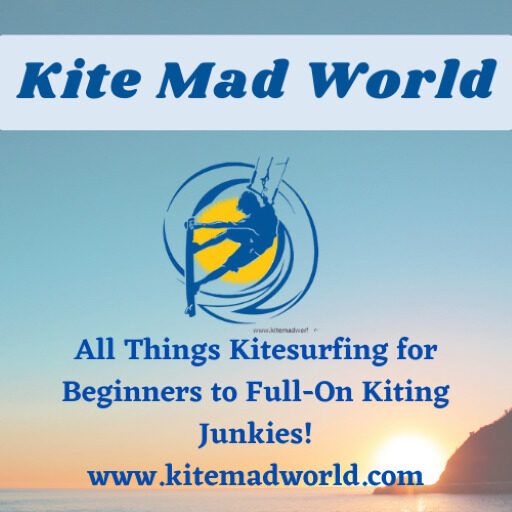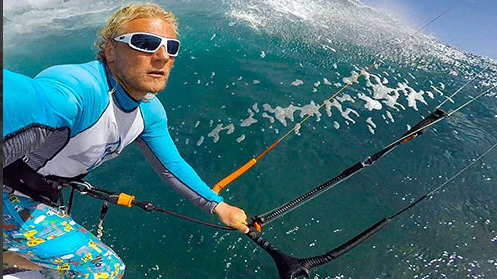Whatever your watersport is, it’s vital to use good quality UV protection sunglasses even when it doesn’t seem all that sunny.
The effects of UVA and UVB on the eyes is now well-known and prolonged exposure can cause long-term damage such as eye cancer, cataracts, macular degeneration and Pterygium (“Surfer’s Eye”).
The problem is that whilst sunburn on the skin is obvious straight away, damage to the eyes is not immediately noticeable. But if you’ve ever come in from a session on the water and experienced tired, aching or watery eyes, then that’s probably a sign of some damage.
What Makes Great Watersports Sunglasses?
I’ve owned a wide variety of watersports shades over the years, and the biggest problem I’ve personally found is that, if you can’t see clearly, or they’re not entirely comfortable, I end up taking them off at some point during a session on the water.
And I’ve lost more than a few pairs over the years because the retention system didn’t work.
This is before we even start with whether they actually do the job of protecting our eyes!
Then you get into polarized/not polarized, colour, amount of UV filtration scratch resistance.
So let’s list the main features you should be looking for:
Lenses
It’s really important that the lenses are up to the job. If you use sunglasses that seem to work because they filter out visual light, but don’t filter the invisible UV, this can actually be more dangerous to the eyes than wearing none.
The pupils of the eyes react to light and close to let less in when it’s brighter. By tricking the pupils into widening, because you’ve filtered out a lot of the visible light, you’re opening them to greater exposure to the UV that gets through inferior lenses.
The main features to look for in the lenses are:
Material – Whilst glass has the most scratch resistance, it’s fragility and weight make it unsuitable for watersports sunglasses. The most frequently used materials are polyamide, polycarbonate and trivex. All of these have a good degree of impact resistance and are reasonably resistant to scratching.
UV400 Lenses – You’ll see this label on any decent pair of sunglasses. It means that any UV rays equal to or less than 400 nano-meters long are filtered completely. That means that 100% of the damaging UV is filtered. But don’t always believe what you read – if the label doesn’t say that 100% of UV is filtered then that should set alarm bells ringing. And in cheaper lenses, the UV filtration efficiency can break down over time.
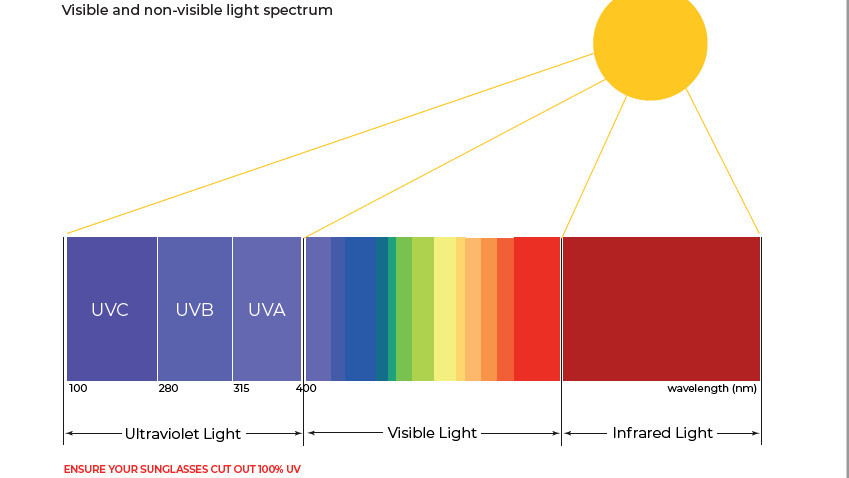
Category 3 –This refers to the Visual Light Transmission (VLT) as opposed to UV. each category has a range of how much VLT gets through the lenses to your eyes. Category 3 has a range of 8 -18% transmission. Category 2 has a range of 18 – 43%. The main effect of VLT is glare. It’s generally accepted that Category 3 is the most appropriate for watersports, although in mixed or cloudy conditions, a lens in the low end of Category 2 might be more appropriate.
Polarized – Light waves oscillate in all directions until they hit a horizontal surface. As they reflect off the surface, such as water or snow, they become horizontal and this is the glare you get when you look at sunlight on water. Polarized lenses only allow vertically oscillating light waves through, so cut out this reflected glare. This is generally better for water or snow sports or driving.
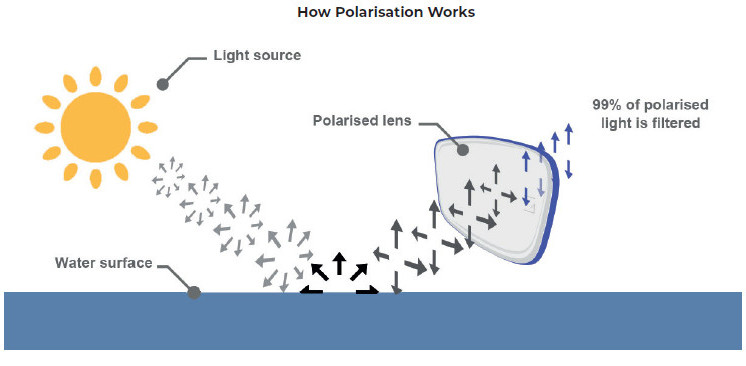
Non-Polarized – The exception to this is when the sun is directly overhead at midday, when the light passes vertically through the water surface and reflects back vertically. This has the effect of making the water surface less visible – the “see-through” effect, and can make it hard to judge the surface. That can be an issue particularly on very still water and is really the only time non-polarized would be better for watersports.
Types of Polarization – Not all polarization is equal! In cheaper lenses the polarization is usually achieved by having a polarizing layer effectively bonded onto the outside surface of the lens. This is very vulnerable to wear and scratching and can also “de-laminate” i.e. become detached. The best lenses have the polarizing layer directly injected into the lens material where it is not going to wear with time.
Colour – Contrary to a lot of people’s understanding, the colour does not have an affect on the UV efficiency of the lenses. But it can affect how much visual light gets through and the contrast of colours. Blue, green, brown and grey based lenses are all good for watersports and will give good contrast in a water based environment. In bright sunshine, blue and grey in particular will be good but filters out a lot of the blue and white light. This can make them less good in more overcast light, when brown or rose based will allow better contrast. Brown is a good all-rounder. But a lot of this choice comes down to what colour you like to see the world in!
Hydrophobic – One of the biggest problems with watersports sunglasses is that as soon as they get splashed, the salt water leaves splodges on the surface of the lens. This is at best irritating and at worst dangerous as it impairs visibility. A hydrophobic coating repels the water splashes so that they roll off the lens before the salt has time to crystallize. There are hydrophobic sprays available but in all honesty I’ve found them to be useless. So a good quality hydrophobic lens is best.
Oleophobic – The other issue with any sports lens is sweat, sun-tan lotion and grease causing smudging that impairs your vision. Oleophobic lenses repel oils, sweat and dust and help keep the lens clear.
Anti-Fog – Particularly when the air or water is cooler, condensation can be a major problem, as water and sweat 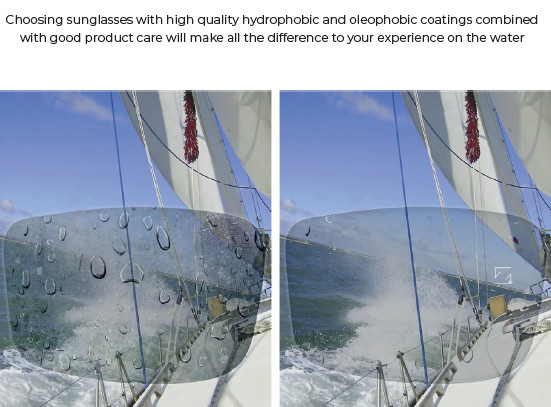 evaporates off the face and condenses on the cooler lens. Whilst there are anti-fog sprays available they rarely work for long. A better solution is to have sufficient venting around the lens frame to allow condensation to vent away.
evaporates off the face and condenses on the cooler lens. Whilst there are anti-fog sprays available they rarely work for long. A better solution is to have sufficient venting around the lens frame to allow condensation to vent away.
Scratch Resistance – The more resistant the lenses are to scratching the better. But nothing will stop scratches if you wipe them when there’s still sand or salt residues on the surface. So at least swish them in the sea before wiping them, but better still, swill them first with fresh water.
Frames
Material – If you’re kitesurfing it’s very likely that at some point you’ll have a wipe-out. If the frame material isn’t strong and flexible it will break and the best case is you don’t have your shades anymore. The worst case is they damage your face. The best material for the frames is TR90 which is extremely strong and flexible and returns to its original shape after flexing.
Size and Shape – For any water sport the frame (and lens) needs to be wider than for a pair of everyday shades. This is because light is reflected from all angles and can get to the eyes from above, side or below. They also need to sit close enough to your face to prevent light, wind and water from getting in as much as possible.
Vents – I mentioned condensation before. The fact is spit, soap or any of the “anti-fog” sprays you can buy for your lenses, will only work until they get the first dunking in the water. An efficient venting system around the lens will blow the condensation away as soon as you start moving again.
Comfort – No matter how good everything else is, if they rub, squeeze or pinch anywhere you’ll probably end up taking them off. So it’s important. Padding around the nose is the minimum you need, but ideally the frames need to be flexible enough to not squeeze your head.
Retention System
Most watersports sunglasses have at least some sort of head strap to keep them in place. But not even that works if you end up face-planting into a wave! The better systems also have a small leash that can be attached to a soft necklace or a wetsuit zip. If yours don’t have this it’s easy to make one.
I’ve learnt the expensive way about this and donated many pairs of water shades to the ocean – until I found the ones I use now!
Not All Water Sports Sunglasses are Equal
If you look on Ebay or Amazon you’ll find some pretty cheap sunglasses claiming to be ideal for watersports. I’ve tried a few of these over the years and found a lot to be a waste of money – they smeared, fogged, broke or were plain uncomfortable.
But there are some great options, and I’ve written another two articles on the two that I would recommend as the best UV protection sunglasses for water sports.
Head on over to my review of the best water sports sunglasses.
